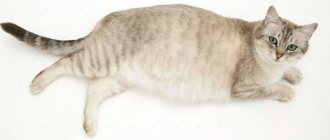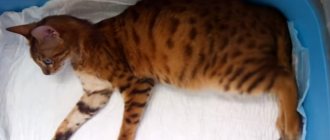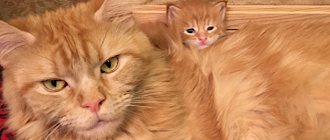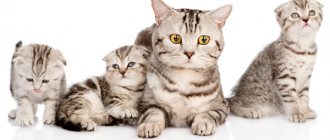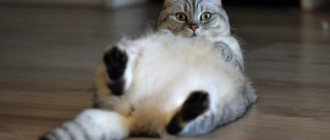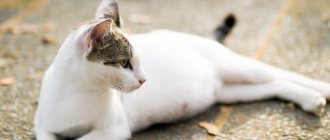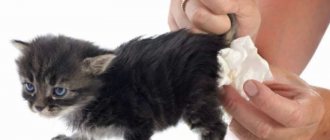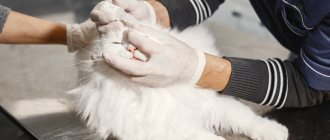The cat's pregnancy calendar will help you correctly calculate the due date, as well as find out how the fetuses develop in a certain week. In the first days after a successful mating, conception occurs. The fertilized egg begins its further development path, and after 60-70 days the long-awaited kittens will be born. In British, Scottish cats, and female Sphynx cats, the duration of pregnancy is almost the same. But the duration of gestation of offspring is influenced by various factors, including age, conditions of keeping and feeding when the first mating took place.
Childbearing age
During puberty, physiological changes occur in the kitten's body, after which it becomes capable of reproducing. The period of onset of childbearing age depends on the following factors:
- breed
- diet
- individual characteristics
- conditions of detention
Short-haired breeds, such as Britons and Siamese cats, mature earlier. Puberty occurs at the age of 5-6 months.
In long-haired and large cats, the first heat comes at 10-12 months.
The optimal age for procreation is from one to one and a half years. Cats give birth without harm to their health starting from the second or third heat.
Interesting to know
Theoretically, a cat can become pregnant at any reproductive age because estrus occurs throughout her life. There is a known case where a cat from Great Britain gave birth to two kittens at the age of 30.
Pregnancy calendar with a duration of 65 days
| January | February | March | April | May | June | July | August | September | October | November | December | |
| Mating | 01.01. | 01.02. | 01.03. | 01.04. | 01.05. | 01.06. | 01.07. | 01.08. | 01.09. | 01.10. | 01.11. | 01.12. |
| Childbirth | 07.03. | 07.04. | 0505. | 05.06. | 05.07. | 05 08. | 04.09. | 05 10 | 05.11. | 05.12 | 05.01. | 04.02. |
| Mating | 02.01. | 02.02. | 02.03. | 02.04. | 02.05. | 02.06. | 02.07. | 02.08. | 02.09. | 02.10. | 02.11 | 02.12. |
| Childbirth | 08.03. | 08.04. | 06.05. | 06.06. | 06.07. | 06.08. | 05.09. | 06.10. | 06.11. | 06.12. | 06.01. | 05.02. |
| Mating | 03.01. | 03.02. | 03.03. | 03.04. | 03.05. | 03 06. | 03.07. | 03.08. | 03.09. | 03.10. | 03.11. | 03.12. |
| Childbirth | 09.03. | 09.04. | 07.05. | 07.06. | 07.07. | 07.08. | 06.09. | 07.10. | 07.11. | 07.12. | 07.01. | 06.02. |
| Mating | 04.01. | 04.02. | 04.03. | 04.04. | 04.05. | 04.06. | 04.07. | 04.08. | 04.09. | 04.10. | 04.11. | 04.12. |
| Childbirth | 10.03. | 10.04. | 08.05. | 08.06. | 08.07. | 08.08. | 07.09. | 08.10. | 08.11. | 08.12. | 08.01. | 07.02. |
| Mating | 05.01. | 05.02. | 05.03. | 05.04. | 05.05. | 05.06. | 05.07. | 05.08. | 05.09. | 05.10. | 05.11. | 05.12. |
| Childbirth | 11.03. | 11.04. | 09.05. | 09.06. | 09.07. | 09 08. | 08.09. | 09 10. | 09.11. | 09.12 | 09.01. | 08.02. |
| Mating | 06.01. | 06 02 | 06.03. | 06.04. | 06.05. | 06.06. | 06.07. | 06 08. | 06.09. | 06.10. | 06.11. | 06.12. |
| Childbirth | 12.03. | 12.04. | 1005. | 10.06. | 10.07. | 1008. | 09.09. | 10.10. | 10.11. | 10.12. | 1001. | 09.02. |
| Mating | 07.01. | 07.02 | 07.03. | 07.04. | 07.05. | 07 06. | 07.07. | 07.08. | 07.09. | 07.10. | 07.11. | 07.12. |
| Childbirth | 13.03. | 13.04. | 11.05. | 11.06. | 11.07. | 11.08. | 10.09. | 11.10. | 11.11. | 11.12. | 11.01. | 10.02. |
| Mating | 08.01. | 08.02. | 08.03. | 08.04. | 08.05. | 08.06. | 08.07. | 08.08. | 08.09. | 08.10. | 08.11. | 08.12. |
| Childbirth | 14.03. | 14.04. | 12.05. | 12.06. | 12.07. | 12.08. | 11.09. | 12.10. | 12.11. | 12.12. | 12.01. | 11.02. |
| Mating | 09.01. | 09.02. | 09.03. | 09.04. | 09.05. | 09.06. | 09.07. | 09.08. | 09.09. | 09.10. | 09.11. | 09.12. |
| Childbirth | 15.03. | 15.04. | 13.05. | 13.06. | 13.07. | 13.08. | 12.09. | 13.10. | 13.11. | 13.12. | 1301. | 12.02. |
| Mating | 10.01. | 10.02. | 10.03. | 10.04 | 10.05. | 1006. | 10.07. | 10.08. | 10.09. | 10.10. | 10.11. | 10.12. |
| Childbirth | 16.03. | 16.04. | 14.05. | 14.06. | 14.07. | 14.08. | 13.09. | 14.10. | 14.11. | 14.12. | 14.01. | 13.02. |
| Mating | 11.01. | 11.02. | 11.03. | 11.04. | 11.05. | 11.06. | 11.07. | 11.08. | 11.09. | 11.10. | 11.11. | 11.12. |
| Childbirth | 17.03. | 17.04. | 15.05. | 15.06. | 15.07. | 15.08. | 14.09. | 15.10. | 15.11. | 15.12. | 15.01. | 14.02. |
| Mating | 12.01. | 12.02. | 12.03. | 12.04. | 12.05. | 12.06. | 12.07. | 12.08. | 12.09. | 12.10. | 12.11. | 12.12. |
| Childbirth | 18.03. | 18.04. | 16.05. | 16.06. | 16.07. | 16.08. | 15.09. | 16.10. | 16.11. | 16.12. | 16.01. | 15.02. |
| Mating | 13.01. | 13.02. | 13.03. | 13.04. | 13.05 | 1306. | 13.07. | 13.08. | 13.09. | 13.10. | 13 11. | 13.12. |
| Childbirth | 19.03. | 19.04. | 17.05. | 17.06. | 17.07. | 17.08. | 16.09. | 17.10. | 17.11. | 17.12. | 17 01. | 16.02. |
| Mating | 14.01. | 14.02. | 14.03. | 14.04. | 14.05. | 14 06. | 14.07. | 14.08. | 14.09. | 14.10. | 14.11. | 14.12. |
| Childbirth | 20.03. | 20.04. | 18.05. | 18.06. | 18.07. | 18.08. | 17.09. | 18.10. | 18.11. | 18.12. | 18.01. | 17.02. |
| Mating | 15.01. | 15.02. | 15.03. | 15.04. | 15.05. | 15.06. | 15.07. | 15.08. | 15.09. | 15.10. | 15.11. | 15.12. |
| Childbirth | 21 .03. | 21.04. | 19.05. | 19.06. | 19.07. | 19.08. | 18.09. | 19.10. | 19.11. | 19.12. | 19.01. | 18.02. |
| Mating | 16.01. | 16.02. | 16.03. | 16.04. | 16.05. | 16.06. | 16.07. | 16.08. | 16.09. | 16.10. | 16.11. | 16.12. |
| Childbirth | 22.03. | 2.2.04. | 20.05. | 20.06. | 20.07. | 20.08. | 19.09. | 20.10. | 20.11. | 20.12. | 20.01. | 19.02. |
| Mating | 17.01. | 17.02. | 17.03. | 17.04. | 17.05. | 17.06. | 17.07. | 17.08. | 17.09. | 17.10. | 17.11. | 17.12. |
| Childbirth | 23.03. | 23.04. | 21.05. | 21.06. | 21.07. | 21.08. | 20.09. | 21.10. | 21.11. | 21.12. | 21.01. | 20.02. |
| Mating | 18.01. | 18.02. | 18.03. | 18.04. | 18.05. | 1806. | 18.07. | 18.08. | 18.09. | 18.10. | 18.11. | 18.12. |
| Childbirth | 24.03. | 24.04. | 22.05. | 22.06. | 22.07. | 22.08. | 21.09. | 22.10. | 22.11. | 22.12. | 22.01. | 21.02. |
| Mating | 19.01. | 19.02. | 19.03. | 19.04. | 19.05. | 19.06. | 19.07. | 19.08. | 19.09. | 19.10. | 19.11. | 19.12. |
| Childbirth | 25.03. | 25.04. | 23.05. | 23.06. | 23.07. | 23.08. | 22.09. | 23.10. | 23.11. | 23.12. | 23.01. | 22.02. |
| Mating | 20.01. | 20.02. | 20.03. | 20.04. | 20.05. | 20.06. | 20.07. | 20.08. | 20.08. | 20.10. | 20.11. | 20.12. |
| Childbirth | 26.03. | 26.04. | 24.05. | 24.06. | 24.07. | 24.08. | 23.09. | 24.10. | 24.11. | 24.12. | 24.01. | 23.02. |
| Mating | 21 .01. | 21.02. | 21.03. | 21.04. | 21.05. | 21.06. | 21.07. | 21.08. | 21.09. | 21.10. | 21.11. | 21.12. |
| Childbirth | 27.03. | 27.04. | 25.05. | 25.06. | 25.07. | 25.08. | 24.09. | 25.10. | 25.11. | 25.12. | 25.01. | 24.02. |
| Mating | 22.01. | 22.02. | 22.03. | 22.04. | 22.05. | 22.06. | 22.07. | 22.08. | 22.09. | 22.10. | 22.11. | 22.12. |
| Childbirth | 28.03. | 28.04. | 26.05. | 26.06. | 26.07. | 26.08. | 25.09. | 26.10. | 26.11. | 26.12. | 26.01. | 25.02. |
| Mating | 23.01. | 23.02. | 23.03. | 23.04. | 23.05. | 23.06. | 23.07. | 23.08. | 23.09. | 23.10. | 23.11. | 23.12. |
| Childbirth | 29.03. | 29.04. | 27.05. | 27.06. | 27.07. | 27.08. | 26.09. | 27.10. | 27.11. | 27.12. | 27.01. | 26.02. |
| Mating | 24.01. | 24.02. | 24.03. | 24.04. | 24.05. | 24.06. | 24.07. | 24.08 | 24.09. | 24.10. | 24.11. | 24.12. |
| Childbirth | 30.03. | 30.04. | 28.05. | 28.06. | 28.07. | 28.08. | 27.09. | 28.10. | 28.11. | 28.12. | 28.01. | 27.02. |
| Mating | 25.01. | 25.02. | 2503. | 25.04. | 25.05. | 25 06. | 25.07. | 25.08. | 2509. | 25.10. | 25.11. | 25.12. |
| Childbirth | 31.03. | 01.05. | 29.05. | 29.06. | 29.07. | 29.08. | 28.09. | 29.10. | 29.11. | 29.12. | 29.01. | 28.02. |
| Mating | 26.01. | 26.02. | 26.03. | 26.04. | 26.05. | 26.06. | 26.07. | 26.08. | 26.09. | 26.09. | 26.10. | 26.12. |
To read: Italian lapdog Bolognese: recommendations for keeping a fragile and delicate pet
Preparing cats for pregnancy
The health of the pet and kittens will depend on proper preparation of the cat for pregnancy. It is useful for owners to know how many months to expect kittens, and what needs to be provided for the cat when bearing offspring.
Any pet needs a balanced diet, especially a pregnant cat. Sometimes expectant mothers suffer from mineral and vitamin deficiencies. This factor has a detrimental effect on development in the womb. That is why, before planning a pregnancy, it is recommended to provide your cat with the right varied diet.
In the process of preparing a cat for pregnancy, it is also advisable to carry out mandatory vaccination and deworming. The fact is that kittens receive antibodies to various diseases along with their mother's milk. Infections are also transmitted to babies.
The final stage is choosing a partner for mating. The choice of a suitable male depends on the breed and pedigree of the cat.
The most optimal period for mating is the third day of estrus. Therefore, it is recommended to introduce the cat to the cat on the second day.
Important
Trying to cover your cat too early on the first day can cause her to become seriously stressed and her heat to stop.
If the fruits are dead...
Sometimes a phenomenon called fetal resorption in a cat can occur, in which resorption (resorption) of the fetus occurs in the uterus. This undesirable effect occurs under various unfavorable conditions: the cat’s health condition and external factors. If the fetus dies in the early stages, while the skeletal system is not formed, this most often passes without negative consequences for the cat’s health. If resorption occurs in the later stages, then such phenomena as mummification (drying), maceration (softening of tissues), petrification (deposition of lime) and putrefaction (putrefactive decomposition) are observed. Such conditions can be life-threatening for the cat and require veterinary intervention.
How long does pregnancy last in cats?
To prepare for childbirth, the owner should know how many weeks or months pregnancy lasts in cats. How long they stay pregnant depends on the breed of cat. The average gestational period (a measure of pregnancy age) is 9 weeks for short-haired breeds, and 10 weeks for long-haired breeds.
| Cat breed | Duration of pregnancy in days |
| Siamese | 59-64 |
| oriental | 65-66 |
| Maine Coon | 66-68 |
| Scottish lop-eared | 62-69 |
| sphinx | 63-66 |
| British Shorthair | 63-69 |
| Bengali | 61-70 |
| Persian | 63-69 |
A cat can become pregnant three times a year, but this frequency negatively affects its health and life expectancy. Therefore, veterinarians advise breeding a pet no more than three times every two years.
Post-term or under-term
Despite the fact that pregnancy lasts on average about 65 days, sometimes you have to give birth early or, conversely, later. It may happen that this action occurs even in the first trimester. In this case, the owner rarely notices this. It’s difficult to even call such a procedure childbirth; it’s more like a miscarriage, which is quite easy and painless for the pet.
There are frequent cases of childbirth at a period of three to six weeks, which is due to illiterate care. Postmaturity is also not uncommon. Therefore, it is very important to know not only how long a British woman’s pregnancy is, but also what stage she is at now. By drawing up a schedule, you can clearly monitor the entire process.
Important! If labor is delayed by more than 7 days, you should immediately contact a veterinarian for help.
Cat pregnancy calendar by week
The onset of pregnancy in cats is accompanied by behavioral characteristics each week. Active development of embryos begins at the end of the second week after conception.
1 week (0-7 days)
During this period, the fertilized egg divides. It is almost impossible to determine the presence of pregnancy.
2 week (8-14 days)
During this period, fertilized eggs are implanted in the uterus. The process of formation of the placenta and embryos begins.
Week 3 (15-21 days)
This week the embryos develop internal organs.
Week 4 (22-29 days)
During the ultrasound, you can already hear the kittens' heartbeat. During this period, it is recommended to be as careful as possible with a pregnant cat: do not pick it up unnecessarily, do not put pressure on the belly.
Week 5 (30-37 days)
Allows you to determine the number of kittens. At the beginning of this week, kittens have already formed paws, pads and soft nails.
6-7 week (38-52 days)
Owners should carefully monitor the nutrition and psychological comfort of their pet, since during these weeks the nervous system of the embryos is formed. X-rays show the complete skeleton of kittens. At the end of the week, the babies are covered with soft fur.
Week 8 (53-60 days)
At this stage, kittens of some breeds are already ready to be born.
9-10 week (61-75 days)
The kittens are already fully formed and ready to be born.
It is quite difficult to calculate exactly how many kittens a cat will bear. It should be taken into account that the offspring is ready for life outside the womb after the 58th day of pregnancy.
How to find out if a British woman is pregnant
It is a mistake to believe that after the first mating you can begin to count down the days until the moment when the cat gives birth to her offspring. Sometimes you have to take your pet to the cat more than once for everything to work out. Therefore, the owner needs to understand what signs can be used to determine that a cat is pregnant.
First signs of pregnancy
To understand that something is happening, you just need to take a close look at the cat. Signs of pregnancy are visible even to the naked eye.
The most striking of them are:
- Swelling of the cat's nipples. If in their normal state their color is closer to white, then with the onset of pregnancy it changes to pink. In addition, the glands become larger in size. This symptom is observed already in the second or third week after mating.
- Nausea. Considering that many animals, including cats, periodically vomit and refuse food, this does not surprise anyone. Unlike people, cats are very smart and understand that overeating is fraught with bad consequences, therefore, they can cleanse their stomach for 1-2 days. That's why many people don't pay attention to nausea. By the way, it goes away very quickly.
- Increased appetite. Starting from the fourth week, a pregnant cat asks for much more food than before. Moreover, the portion can be 2-3 times larger than usual. In addition, the future cat mother visits the kitchen more often and sits near her bowl.
- Desire to be alone. A cat that is expecting offspring behaves much quieter than usual. She doesn't want to play, and she tries to spend most of her time lying down. An attentive owner will immediately notice that the pet has begun to avoid sudden movements and has also stopped stretching out.
- Drowsiness. The cat saves its energy and rests a lot, so it tries to retire somewhere, finding a secluded place.
- Abdominal enlargement. Usually this is clearly noticeable in the second month of pregnancy. If you gently press on the “ball”, you can even feel small lumps inside, the size of which is in the range of 2.5-3 cm. They increase noticeably in the last two weeks of pregnancy.
Having realized that the British cat is bearing kittens, you need to take care of her proper diet. It is recommended to feed the animal food that contains a lot of protein, phosphorus and calcium. Many veterinarians advise switching to special food during this period.
Important! Sometimes an enlarged abdomen and a desire to be alone indicate not pregnancy, but pyometra, so if the cat is fussing and behaving very strangely, then this is a reason to immediately consult a specialist.
How to determine gestational age
Only a veterinarian can determine the exact gestational age of a British cat. This can be done using an ultrasound, the size of the abdomen, as well as lightly palpating it. As for the owner himself, he can only guess how long the cat has already been in an interesting situation, and how long it will take for her to become a mother. The pregnancy of a British cat begins to count from the moment of mating with the cat. It won't be difficult to calculate this. However, to accurately determine the date of birth, you cannot do without a specialist.
Number of kittens and gestational age
The maximum number of kittens a cat can produce depends on the number of attachment sites for fertilized eggs in the uterus. On average, a cat gives birth to 4 to 6 kittens. At young and old ages, the number of offspring is significantly lower.
Interesting to know
Some breeders believe that the maximum number of kittens that a cat can give birth to can be calculated independently. To do this, just use a simple formula: subtract 2 from the total number of cat nipples.
The length of time cats are pregnant depends on how many kittens are preparing to be born. If there are less than five kittens in the belly, the pregnancy lasts 9-10 weeks; if more, labor may begin a little earlier than expected.
Owners can find out the number of expected offspring as early as the fifth week of a cat's pregnancy.
Childbirth
Before the onset of labor, a British cat restlessly follows its owner, meows anxiously, and licks its fur. You need to be especially careful the day before the expected event. Within 12-14 hours, body temperature begins to drop to 37.9 °C. Before labor begins, it is necessary to study the main stages of the birth of babies.
As soon as contractions begin, you need to put her in a prepared box with a clean diaper. The crumbs appear at intervals of 40-60 minutes. Kittens are born in a bubble. The mother chews the shell and licks the cubs: it stimulates the respiratory function of newborns. After this, the cat chews the umbilical cord. The animal most often eats the delivered placenta.
The birth process lasts from 2 to 14 hours.
Why might there be few kittens?
Having studied the question of how many babies British breed cats give birth to for the first time, you may not be surprised at the appearance of one baby from a young favorite. In the first litter, 1-3 cubs are usually observed.
Why can there be many kittens?
Multiple births are transmitted through the female line and depend on the number of previous lambings. An adult cat that has given birth can produce more kittens, 4-5. Especially if she herself appeared as a result of a multiple pregnancy.
Different kittens from the same litter
Genetically identical babies may differ in color. Babies receive a different set of genes from their parents, which is why different kittens appear from the same litter.
How to determine pregnancy
The primary signs indicating pregnancy in a cat are easy to recognize.
Among them:
- nervousness and aggression
- increased appetite
- enlargement and change in color of nipples
- toxicosis
- weight gain in the body
The general condition and behavior of the cat is also affected by the duration of pregnancy.
1-3 weeks of pregnancy in a cat
In the first week after mating, it is impossible to determine whether the cat is pregnant or not. There are no characteristic signs in her behavior.
From the second to third week of pregnancy, the cat's nipples swell and change color. They may darken or, on the contrary, acquire a rich pink color.
Changes in hormonal levels cause lethargy, drowsiness and nervousness. Sometimes vomiting and loss of appetite are possible. Based on these signs, the owner can determine that the expectant mother is carrying kittens in her womb.
4-6 weeks of pregnancy in a cat
Starting from the fourth week of gestation, the expectant mother’s appetite returns with renewed vigor. The cat begins to rapidly gain weight and sleep a lot.
At the sixth week of pregnancy, there is no doubt that the cat is bearing offspring. Owners may notice faint movements in the kittens' stomach. However, trying to palpate the abdomen with force is still dangerous. To feel the weak tremors of kittens, just gently place your palm on the cat’s stomach.
7-9 weeks of pregnancy in a cat
At the seventh week, the cat has a noticeable rounded belly, and the kittens begin to actively move in the womb.
At the eighth week, the cat begins to prepare for childbirth. She licks herself more often and tries to find a secluded place for the upcoming event.
Important
Pregnancy can last 10 weeks, but the owner should closely monitor the cat's behavior starting from the eighth week. If the expectant mother has chosen a convenient place for herself, the owner can help arrange it. For example, lay down a soft cloth, and prepare in advance everything that may be needed to assist in childbirth.
Preparing for childbirth
The owner should carefully monitor the behavior of the British cat when the due date approaches. Signs may include: crying, purring, chasing the owner, licking his crotch. It is worth agreeing in advance with the veterinarian about his visit if necessary or if it is possible to contact by phone.
You need to prepare for childbirth:
- fat cream, Vaseline;
- clean diapers or disposable wipes;
- cotton wool;
- threads;
- sterile scissors;
- heating pad;
- hydrogen peroxide;
- water for drinking.
Photo of pregnancy in a cat
The pregnant cat in the photograph has characteristic visual signs: enlarged nipples, a rounded belly.
Caring for a pregnant cat
A pregnant cat needs proper care from the owner. Experienced breeders know that the health of her offspring depends on the quality of care for the expectant mother. At all stages of pregnancy, veterinary supervision is recommended. This is necessary to prevent or detect pathologies.
Features of feeding
Proper feeding of a pregnant cat should take into account the peculiarities of physiological changes at different stages of gestation of kittens.
In the first half, the expectant mother's appetite increases, which leads to an increase in her body weight. During this period, it is important to prevent the animal from becoming obese.
The second half of pregnancy with an incorrect diet, on the contrary, is fraught with exhaustion of the cat. Appetite decreases, essential microelements are supplied to the embryos, and the mother’s body suffers from a lack of calories and essential nutrients.
With a lack of minerals, the bone tissue of a pregnant cat weakens. This can lead to the development of joint problems. For embryos, this problem threatens rickets.
Salt metabolism disorders and calcium deficiency have a bad effect on dental health. And inadequate intake of vitamins often leads to pathologies in the development of kittens in the womb. That is why owners of a pregnant cat need to ensure that the diet is balanced.
In the first two to three weeks after mating, it is recommended to increase the total daily feeding portion by 10%. The frequency of feedings should be on average 4-5 times a day.
After the third week, daily feeding should be increased by another 50%. Owners may be faced with the desire of a pregnant pet to beg for a piece from the table. But you don’t need to give in to this, because the cat quickly gains weight, and obesity has a bad effect on the course of childbirth.
At the end of pregnancy, the kittens that have grown in the womb begin to put pressure on the mother’s belly. This causes loss of appetite. The correct solution in this situation is split meals with a feeding frequency of at least 6 times a day. At the same time, the total daily norm should remain the same.
A week before the expected birth, veterinarians recommend returning to the standard daily pre-pregnancy feeding rate. Typically, the frequency of feedings does not exceed three times a day. The diet depends on what food the cat is accustomed to. If this is natural food, then the owner is recommended to pay attention to the following products:
- Meat. Rich in protein content. It is better to give it boiled.
- Fish. Rich in phosphorus and proteins. It should be given exclusively in boiled form, no more than once every 10 days.
- Cottage cheese. Rich in calcium. Include no more than 50 grams per week in your diet.
- Vegetables. Rich in vitamins. From mid-pregnancy you can include up to 80 grams per day in your diet.
Interesting to know
If the cat refuses to eat vegetables, chop them in boiled form and mix with meat puree.
The owner of a pregnant dry food lover is advised to choose a quality product. Many manufacturers produce dry food specifically for pregnant animals. But if your usual brand doesn’t have such a line, kitten food is perfect. Many breeders note that dry food for kittens ideally meets all the needs of a pregnant cat.
Regardless of the nutritional option, the expectant mother will benefit from taking vitamins. But it is not advisable for the owner to select them himself. It is much better to seek help from a veterinarian.
Is it possible to get vaccinated?
Veterinarians advise vaccination before planning pregnancy, and do not recommend during. If the owner has not had time to get all the necessary vaccinations, then it is better to wait until the end of pregnancy.
Pregnant cats do not tolerate vaccination well, and kittens in the womb do it even worse. Some drugs can cause birth defects in offspring, while others can cause miscarriage.
Is it possible to give medications?
It is not advisable to give medications to a cat during pregnancy. An exception may be the treatment of diseases during pregnancy and homeopathy, but strictly under the supervision of a veterinarian. The following medications and substances are strictly prohibited:
- Tetracycline
- sulfonamides
- Levomycetin
- female and male sex hormones
- glucocorticoids
- anticonvulsants
Pregnant cats can also be harmed by consuming certain herbs. For example, motherwort and raspberry leaves cause uterine contractions, while clover and licorice cause serious hormonal imbalances.
Is it possible to pick up a cat?
In the early stages of pregnancy, it is better not to handle the animal. If the cat itself asks for this, you should be careful not to put pressure on the abdominal area and support the pet from below.
Some cats that bear offspring prefer a vertical position in their arms. To do this, the owner can hold the animal by the paws with one hand and support it from below with the other. This way the cat is in a comfortable sitting position.
Nutrition and vitamins
Proper nutrition during pregnancy plays an important role in the formation of future babies. Therefore, veterinarians advise feeding your cat a balanced diet (there are special product lines designed for pregnant women). In addition to the daily diet, you can give your furry pet vitamins (Doctor Zoo, Seva, Canina, etc.).
You should not combine fortified feed and vitamins, as this can lead to the development of vitamin deficiency.
Nuances and possible complications
Owners are advised to monitor their cat's pregnancy at a veterinary clinic. This is due to the fact that during the gestational period one may encounter the peculiarities and complications of childbirth.
Among them:
- first pregnancy,
- long or short gestation period
- frozen pregnancy in cats
- And so on
Maximum delay in labor
It is common for some breeds to bear offspring for 10 weeks. Normal pregnancy duration is up to 72 days. If birth has not occurred after this period, it is recommended to seek help from a veterinarian. Delayed birth is life-threatening for kittens and their mother.
Premature birth also poses a risk. Kittens born before the 58th day of gestation are very weak and most often die.
What are the dangers of early pregnancy?
Many pet owners mistakenly believe that with the arrival of the first heat, the cat is ready for pregnancy and childbirth. The young cat’s body is too weak and is not capable of bearing healthy offspring.
Experts believe that the optimal age at which a cat can become pregnant for the first time varies from a year to a year and a half. With the arrival of the first heat, at the age of 6-8 months, the animal is still just a child, so pregnancy is out of the question.
Features of the first pregnancy
Carrying kittens for the first time requires special attention from the owner. For the first time, the expectant mother experiences new sensations associated with hormonal changes. Therefore, it is recommended to provide the cat with the most comfortable psychological environment possible. Sometimes the female can be nervous and act a little aggressive, but the owner should take this calmly and not frighten the pet.
Also, due to its inexperience, a young cat can behave sloppy and too active. For example, an animal may jump from a height and hit its stomach. This is fraught with miscarriage. The owner should prevent this from happening.
It is best to conduct your pet's first pregnancy under the supervision of a veterinarian. This way, the cat and her future offspring will definitely be safe, and the owner will learn how best to behave with a pregnant animal, will be able to choose proper nutrition and vitamins, find out the timing of pregnancy, and be prepared for the appearance of kittens.
False pregnancy
This condition occurs in a cat after mating without fertilization. Sometimes false pregnancy can occur in untied females.
Normally, in this state, a cat can sleep for a long time and require a lot of food. The nipples often swell and change color.
Only a veterinarian can help distinguish a false pregnancy from a real one. This is done by palpation of the abdomen or ultrasound. If false pregnancy occurs frequently, sex hormone levels are checked. If they increase, it is recommended to sterilize the cat.
Signs of pregnancy in a Scottish cat
Pregnancy of a Scottish cat living in an apartment or house, without access to the street or contact with other animals, without stress and eating properly, is a wonderful period. It should not cause much inconvenience to either the cat or the owner.
Pregnancy tests for cats have not yet been invented, so if you definitely need to determine its presence in the early stages, pay attention to the following signs:
- the cat is sick in the morning (she has toxicosis);
- nipples swell and turn pink;
- her appetite increases and her eating preferences may change;
- her character changes;
- she sleeps more and acts a little lethargic;
- Pregnancy becomes obvious to the naked eye only in the sixth week, but after 2 weeks it can be determined by a professional using ultrasound and palpation.
Kittens on x-ray
Frozen pregnancy
Cat owners should be prepared for a frozen pregnancy. This happens quite often. Pathology is usually detected in a veterinary clinic using ultrasound. But if the cat’s pregnancy was not under the supervision of a specialist, the owner can recognize the problem on his own.
The following symptoms indicate this:
- bloody discharge from the vulva
- animal aggression upon palpation of the abdominal cavity
- absence of characteristic signs of pregnancy
- decreased appetite and thirst
- lethargic state
- increase in body temperature
There are many reasons for a cat's miscarriage. Among them are mainly hormonal disorders, infections, and stress.
If the veterinarian has determined that the embryos have died, then further actions depend on the clinical picture. A cat may have a spontaneous abortion. In this case, the doctor examines the uterus and determines whether the pet needs cleaning.
If all embryos die and there is no miscarriage, the cat is prescribed an abortion. This is a mandatory procedure, since the death of a kitten in the womb is fatal for a pregnant cat.
The most favorable situation is when not all embryos die. Veterinarians rarely intervene in this pathology of pregnancy, since the frozen fetus is released along with the live kittens during childbirth.
Superfetation
There are cases when a pregnant cat continues to experience cravings for the cat. If representatives of both sexes live together, it is recommended that the owner separate them during the female's pregnancy to prevent superfetation.
Superfetation is the re-conception of an already pregnant cat. In the uterus, embryos develop with a significant difference in development, while pregnancy can proceed normally, without increasing the gestation period. Most often this ends in the death of the second premature offspring.
If superfetation does occur, it is best to carry out the birth under the supervision of a veterinarian. Sometimes a doctor can save some premature kittens from a younger litter.
Possible complications
In the absence of proper nutrition, in case of hypothermia or overheating of the body, if the cat is infected with pathogenic microorganisms, the following complications are possible:
- Miscarriage (usually occurs at 4–5 weeks of pregnancy). In this case, lifeless fetuses may remain in the uterus, which will cause putrefaction and inflammation of the internal genital organs. In this case, you cannot do without the help of a veterinarian.
- Bleeding. It occurs as a result of rupture of the cervix during childbirth: scarlet fluid flows profusely from the vulva, and the cat lies on its side with its tongue hanging out. In the absence of timely treatment, the animal may die.
- Mastitis (inflammation of the mammary glands as a result of excess milk). In this case, redness and soreness of the nipples are observed, and yellowish breast discharge appears. In this case, the cat is isolated from the kittens and special treatment is carried out.
- Metritis (inflammation of the uterus due to infection). In this case, the animal becomes apathetic, the body temperature rises, and there is abundant discharge from the vulva with an unpleasant odor.
- Insufficient amount of milk (occurs, for example, with a large number of kittens, with a lack of adequate nutrition or fluid).
Caring for the health of a pregnant cat
During cat pregnancy, many owners worry about the health of the expectant mother and kittens. With proper care, the expectant mother will produce healthy offspring. The main thing is to provide your pet with peace and proper nutrition.
It is recommended to ensure sufficient amounts of clean drinking water, since pregnancy is often accompanied by thirst. Paying attention to the cat is also very important; the expectant mother needs love and affection.
The cat's litter box should always be clean. This is necessary to avoid the development of infections in the animal’s body.
Preparing a place for a pregnant cat
It is better to prepare the place for childbirth in advance. No one knows how long a cat's pregnancy will last. In addition, she needs to get to know the new home and determine whether it is suitable for having kittens. There are many options for a birthing place. The simplest of them is a cardboard box. It is enough to cover its bottom with a warm cloth. Closer to childbirth, you can use disposable diapers. They will help keep the place clean.
In the store you can buy a basket with a soft mattress. But this option is not always suitable for cats, since they try to choose a secluded place for childbirth.
A large cage may also be a good option. It can easily accommodate a sleeping area, food and water bowls, and a cat litter box. But at the same time, it will be inconvenient for the owner to control the birth.
Interesting to know
Experienced breeders consider playpens to be the most convenient place for childbirth.
When arranging a place for a cat, owners are advised to take into account some features.
The location should be:
- warm, cozy and protected from drafts
- safe for kittens
- quiet and secluded
- convenient for cleaning
Taking these tips into account, the owner will be able to create a comfortable place for childbirth.
The main pathologies of pregnancy that affect timing
There are cases when during pregnancy a cat is attracted to the male. At such moments, it is worth isolating your pet from sexual intercourse. If the ligament does occur, then a “double” pregnancy occurs in the womb and the cat bears two litters. There may be two scenarios for the development of events.
Sometimes during pregnancy a cat wants a cat
The first and most common is the birth of a healthy first batch and miscarriage of the second, since they did not have time to develop.
In the second case, the first kittens are born, while the second remain in the womb; the cat carries them to term and gives birth later. You need to understand that it will be impossible for one mother to feed all the kittens, and you will have to feed the rest of the animals. This happens very rarely.
False pregnancies occur in cats. Based on the signs and symptoms, you might think that the cat is pregnant, but you will not feel the movement of the embryos, and labor will not occur. Pathology appears due to hormonal disorders.
Against the background of a “spoon” (false pregnancy), ascites may develop. The exact reason is unknown, but experts think that protein metabolism is disrupted due to the play of hormones and fluid accumulates in the abdomen.
It will appear pregnant, but an x-ray will show that the cat is not pregnant.
More precise details can be revealed by ultrasound. It is impossible to cure the disease.
All problems during pregnancy can be determined by doing an ultrasound.
And another pathology is frozen pregnancy. It consists of stopping the development of embryos and their death. The reasons may be infections, hormonal imbalances, stressful conditions, injuries, neoplasms in the pelvis and abdomen.
If the tummy does not increase, and there are no tremors, appetite disappears and lethargy appears, immediately contact a specialist.
An ectopic pregnancy is very dangerous for the animal. If the embryo develops in the wrong place, the uterus may rupture, which will lead to internal bleeding and the cat will urgently need surgery.
If your cat has an unpleasant discharge, the temperature is constantly changing and obvious signs of illness and anxiety are visible, this may indicate a miscarriage. Embryos can die at a very early stage and be resorbed. They may die and leave the womb or remain in it until the end of pregnancy. It is very difficult to predict such a condition.
If a cat has any of the listed pathologies, it is best to sterilize it after treatment.
Recommendations for organizing childbirth in a cat
Healthy cats usually give birth on their own and require only attention and support from the owner. But some purebred pets may require human assistance and supervision of the birth of kittens.
First birth
A cat that is about to give birth for the first time can make many mistakes due to its inexperience. In addition, labor takes longer, and contractions are much weaker and longer lasting. Therefore, a person is recommended to be present during childbirth and monitor the process.
A cat giving birth for the first time is very tired. For this reason, when giving birth to the last kittens, she may accidentally crush the previous ones. But if the owner or veterinarian supervises the delivery process, the kittens will be safe.
A young cat sometimes does not remove the birth bladder from the kitten well, and it suffocates. To organize assistance in such a situation, the owner is recommended to keep sterile gloves, scissors and a dry cloth on hand. The goal of the assistance is to free the baby’s face from the birth bladder as quickly as possible. Then the kitten will not have time to suffocate.
Start of labor
Before the onset of labor, the cat begins to behave restlessly, often lick itself, and scream. The cat’s water also breaks and contractions begin.
The birth process occurs in stages. In the intervals between the birth of kittens, the first and second stages are repeated, and the third indicates the end of labor.
- Contractions. After the cat's water breaks, contractions begin, which help dilate the cervix. The period lasts on average from 3 to 6 hours. At this time, the cat breathes rapidly, looks for a suitable place and nests. The help that a person can provide is moral support and encouragement.
- Attempts and the appearance of kittens. During this period, contractions are usually at their most painful, so the owner can help the cat with stroking and affection. Normally, during the process of pushing, the amniotic sac bursts, releasing a small amount of fluid. After this, the first kitten is born.
- The appearance of the placenta. The placenta comes out with the born kitten or immediately after. A sign of the end of labor is characterized by calmness and even breathing of the cat. Contractions gradually stop, and the animal's abdominal cavity becomes soft.
It is important to know
The average duration of labor in cats is 4-12 hours. If labor lasts for a day or more, be sure to seek help from a veterinary clinic.
Assistance during childbirth
The help of the owner or veterinarian depends on how difficult the cat's birth is. It is impossible to predict how the natural process will unfold, so it is recommended to be prepared for anything and act according to the situation.
In the case of an easy birth, practically no human assistance is required. It is enough to ensure that the cat does not accidentally crush the born kittens. You can also count the number of kittens and placenta; normally, the number should match.
Typically, cats chew the umbilical cord on their own, eat the afterbirth, and lick the mucus from the kittens. If the cat does not do this, a person should intervene in the process.
To begin with, it is recommended to rid the kitten of mucus and clean the nasal passages and mouth using a pipette. Then carefully cut off the umbilical cord 4 centimeters from the abdomen, rewind it with thread and process it. Don't let your cat eat more than two afterbirths. Despite containing beneficial microelements, they cause stomach upsets.
In cases of difficult childbirth, human assistance is essential. Stopping labor can happen when kittens get stuck or several are pushed out at the same time. In this case, you can help remove the stuck fruit. To do this, it is recommended to wear sterile gloves, lubricate your fingers with Vaseline and place them in the cat's vagina. Then very carefully feel the kitten’s withers and try to pull it out with progressive movements. It is strictly forbidden to pull the baby by the paws, head or tail.
Important!
If the owner is not confident in his abilities, it is better to seek help from a veterinarian.
How to help a Scottish woman during childbirth
When the time comes for the kittens to leave their mother’s womb, the kitty will definitely notify its owner. Typically, an animal before giving birth behaves like this:
- Meows loudly, rubs against the owner’s legs;
- Calls on a person to be present near the “nest”;
- Licking the crotch;
- Breathes frequently.
The breaking of water, abdominal contractions, and a decrease in body temperature are clear signals that labor is about to begin. In a pre-prepared “nest” (for example, a box or basket), you need to lay a clean cloth and a diaper on top. You need to have disposable diapers, disinfected scissors, threads, a disinfectant (for example, hydrogen peroxide), a heating pad with warm water, and Vaseline at the ready.
When the cat clearly begins to give birth, it is permissible to assist by carefully guiding the kittens towards the exit. When the baby's head and shoulder blades appear, you can slightly pull him towards you by the withers with clean hands lubricated with Vaseline, but only if the contractions are weak. Following the kitten, you need to remove the placenta (if the cat herself did not push it out). The baby's umbilical cord must be cut and disinfected (at a distance of at least 2 cm from the abdomen), after having tied it with thread. Then the newborn should be placed closer to the mother's nipples, giving the cat the opportunity to feed and lick the child. After the kitten, you need to wipe it with a napkin and place it on a warm heating pad, giving the cat the opportunity to give birth to the rest of the babies.
Caring for a cat after pregnancy and birth
In the first week after birth, the owner is advised to monitor the general condition of the young mother. A veterinarian can help with this. The doctor will tell you which consequences of childbirth may be normal and which may not. For small kittens, it is advisable to feed on mother’s milk, so the owner should try to maintain the cat’s lactation for two months. Good nutrition and a calm atmosphere in the house will help with this.
A young cat mother needs to consume magnesium and calcium, which is contained in high-quality specialized food. Dry food can replace fermented milk products or nutritional supplements. The cat owner should help the cat develop a weak maternal instinct. Cats tend to leave their place, periodic reminders of the kittens will help the young mother understand that it is important not to forget about her offspring.
Premature birth
Premature birth is considered any birth less than 60 days. You can save the offspring if birth occurs no earlier than 50–55 days. When labor begins a week early, kittens often die.
When can premature labor begin:
- If a cat has more than five kittens in a litter, then labor will begin earlier.
- If the animal catches the infection, then labor will begin prematurely.
- The duration is also affected by the cat’s build and age. Very young cats (up to a year) give birth on the 50th day, but the offspring are most often unhealthy.
- Small cats do not walk with a belly for more than 65 days.
- In Scottish women, normal labor takes place in at least 60 days.
- If a young cat gives birth early (at about 1 year), then labor takes up to 60 days. In this case, the offspring may also be unhealthy.
- Premature labor can begin due to a sudden change in temperature.
- Weak embryos die inside the womb, causing early labor.
- If the cat is very scared or nervous.
If your cat’s behavior has become strange or its condition has worsened, contact the clinic, where they will do everything necessary to help. You can remove the tone of the uterus to continue pregnancy, or induce premature birth or perform a caesarean section.
Due to a stressful situation, the cat may give birth earlier or the birth may be delayed.
How to care for newborn kittens
A newborn kitten has little fur and freezes quickly. A lamp installed above the box can help retain heat. If the cat refuses to stay with the newborns, a warm heating pad will help replace it.
If a cat stops lactating, kittens should be fed formula. Your veterinarian will help you choose the right milk replacer.
In other situations, the cat is able to independently deliver newborn kittens. The older offspring also learn basic skills from their mother, including using a litter box.
Important
Cat's milk cannot be replaced with cow's milk. Otherwise, kittens experience acute intestinal upset.
Post-term pregnancy
A post-term pregnancy is a pregnancy that lasts up to 70 days or more. The normal delay in labor is one week if the mother feels well. Delay does not always lead to pathologies or unhealthy kittens, but it is also not considered the norm.
Reasons for delayed birth:
- If the offspring is expected to be small, then gestation will be longer.
With small offspring, pregnancy lasts longer
- Also, the period may be delayed if the cat was exposed to stress in the last stages.
- Larger and older Scottish females bear offspring longer.
- An older cat may have a longer period if she gives birth for the first time.
- Frozen pregnancy.
- Hypoxia in kittens is an insufficient amount of oxygen supplied.
An ultrasound will show the exact cause of the delay.



